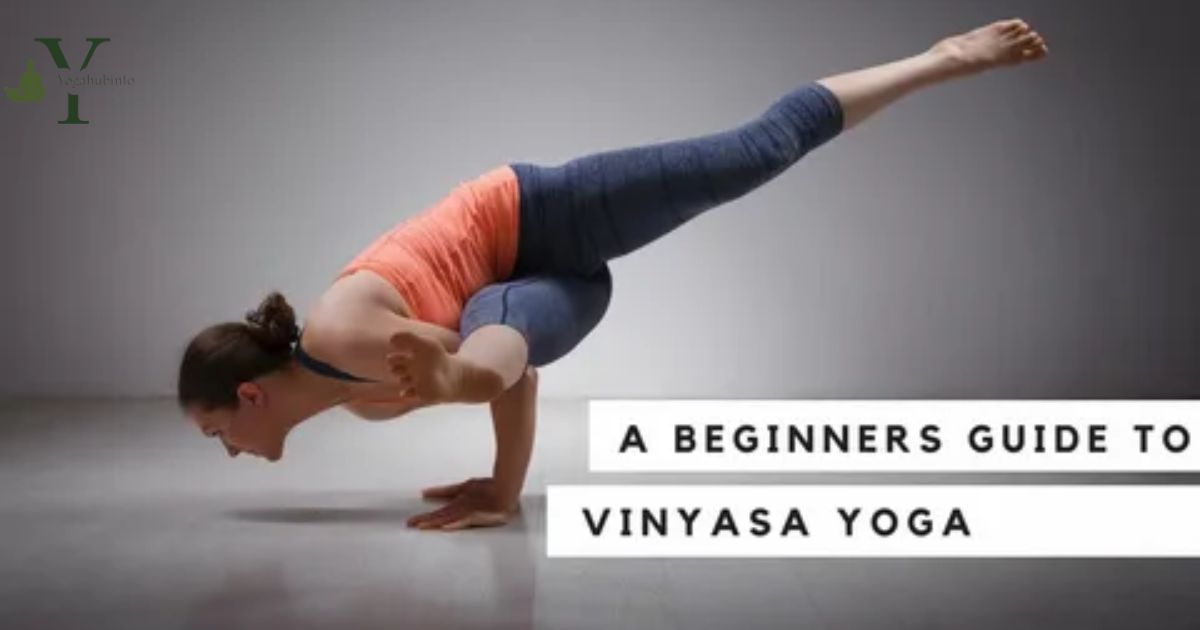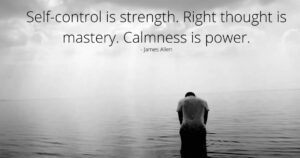Answer. Vinyasa Yoga is a dynamic style that synchronizes breath with movement, emphasizing a continuous flow between yoga poses. It promotes flexibility, strength, and mindfulness through a fluid and harmonious practice.
Vinyasa Yoga is a dynamic style of yoga that synchronizes breath with movement. It involves smoothly transitioning between poses, creating a flowing sequence. The practice emphasizes connecting breath and poses to promote flexibility, strength, and mindfulness. Vinyasa Yoga is known for its creative sequences and adaptability, making it accessible to practitioners of various levels.
Step into a world of fluid movement and mindful breath welcome to Vinyasa Yoga. Discover the art of seamlessly connecting poses with your breath, fostering strength, flexibility, and inner calm. Join us on a journey where each flow becomes a dance, and each breath guides you to a harmonious balance of body and mind. Embrace the transformative power of Vinyasa Yoga with us today.
Vinyasa Yoga is a dynamic form of yoga that emphasizes the coordination of breath with movement. In this practice, poses flow seamlessly from one to another, creating a continuous, dance-like sequence. The word Vinyasa translates to flow, reflecting the fluidity and rhythm inherent in this style. Practitioners often find Vinyasa Yoga both invigorating and meditative, promoting flexibility, strength, and mindfulness.
What’s the definition of vinyasa yoga?
| Aspect | Definition of Vinyasa Yoga |
| Name | Vinyasa Yoga |
| Definition | A style of yoga that emphasizes the coordination of breath and movement. It involves smoothly transitioning between different yoga poses in a flowing sequence. |
| Breath Awareness | Focus on the breath is crucial, with movements synchronized with inhales and exhales. |
| Flowing Sequences | Characterized by continuous, dynamic sequences of yoga poses, often referred to as “flow.” |
| Transitions | Emphasis on smooth transitions between poses, creating a sense of fluidity and connection between movements. |
| Physical Challenge | Can be physically demanding, as it often involves a series of poses that build strength, flexibility, and endurance. |
| Mind-Body Connection | Encourages a strong connection between the mind and body through the integration of breath, movement, and mindfulness. |
| Variations | Different schools or instructors may have variations in the sequences, allowing for creativity and personal expression. |
Vinyasa yoga: Dance of breath and movement
Imagine a graceful flow, where breath guides your body like a silent melody. That’s vinyasa yoga! Vinyasa means “to place in a special way,” and in this practice, each movement is like a brushstroke, painting a moving sequence of yoga postures.
Breathe, move, connect
Inhale, as you reach towards the sun. Exhale, as you fold like a willow branch. Every breath connects you to your body, creating a mindful dance of strength and flexibility. Sun salutations, warrior poses, and twists become a continuous conversation, guided by your rhythmic breath.
Unleash your inner flow
No two vinyasa classes are alike. The teacher weaves a unique tapestry of postures, letting you explore your Grenzen and celebrate your victories. Whether you’re a seasoned yogi or just starting out, vinyasa welcomes you to move, breathe, and discover the joy of your own inner flow.
What’s the history and origin of vinyasa yoga?
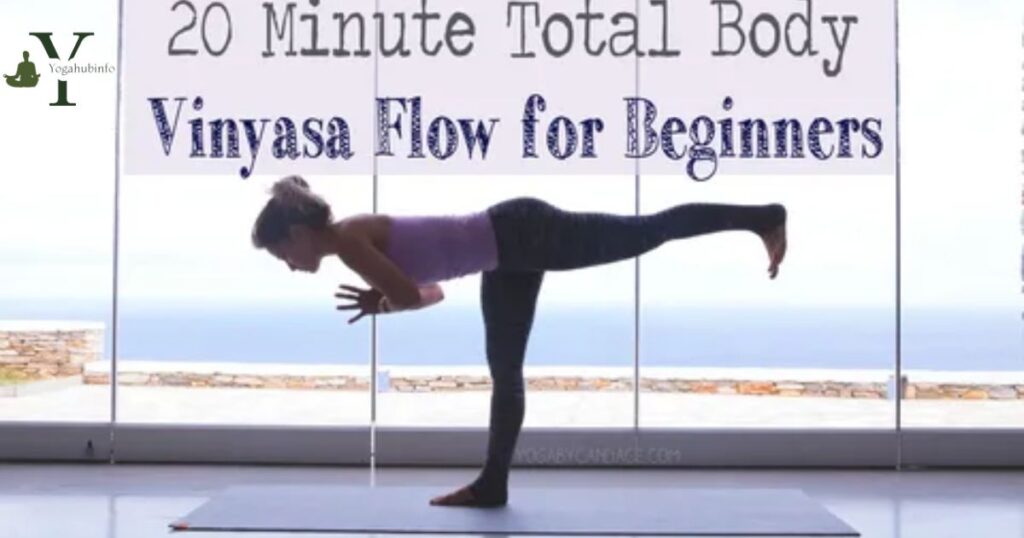
Vinyasa yoga is a popular and dynamic style of yoga characterized by its flowing sequences of postures synchronized with breath. But where did this energetic practice come from? Let’s take a journey through the fascinating history and origin of vinyasa yoga.
Ancient Roots
While the modern form of vinyasa yoga is relatively recent, its roots can be traced back to ancient India. The Sanskrit word “vinyasa” itself means “to place in a special way,” hinting at the practice’s focus on mindful transitions between postures. References to vinyasa-like movements can be found in ancient yogic texts like the Yoga Korunta and the Hatha Yoga Pradipika.
The Father of Modern Yoga
The 20th century saw a revival of yoga in India, and a key figure in this movement was T. Krishnamacharya, often referred to as the “father of modern yoga.” Krishnamacharya was a scholar and practitioner who emphasized the importance of adapting yoga to individual needs. He developed a dynamic style called Vinyasa Krama, which incorporated flowing sequences based on breath and linked movements with mindful transitions.
Ashtanga Vinyasa and the Mysore Style
One of Krishnamacharya’s influential students was K. Pattabhi Jois, who further refined the Vinyasa Krama approach into Ashtanga Vinyasa. This practice involved a set series of postures performed in a specific order with synchronized breath. Jois’ teaching in Mysore, India, attracted students from around the world, including Norman Mailer and Andre van Lysebeth, who helped spread the Ashtanga Vinyasa tradition to the West.
Evolution and Diversification
As vinyasa yoga gained popularity, practitioners began to experiment and diverge from the traditional Ashtanga Vinyasa sequence. This led to the development of various vinyasa styles, each with its own unique flow and emphasis. Some popular variations include Power Vinyasa, Flow Vinyasa, and Yin Yoga.
Vinyasa Today
Today, vinyasa yoga is one of the most popular styles in the world, appealing to practitioners of all levels and backgrounds. Its dynamic and creative nature offers a challenging workout while promoting mindfulness and inner peace. Vinyasa continues to evolve, with new teachers and studios constantly developing fresh and innovative approaches to this ever-growing practice.
Key Takeaways
- Vinyasa yoga has ancient roots in Indian yogic traditions.
- T. Krishnamacharya and K. Pattabhi Jois played pivotal roles in its development.
- Ashtanga Vinyasa served as a foundation for various vinyasa styles.
- Vinyasa yoga continues to evolve and diversify, offering something for everyone.
So, the next time you step onto your yoga mat and flow through a vinyasa sequence, remember the rich history and lineage behind this dynamic practice. It’s a journey that began thousands of years ago and continues to inspire and empower yogis around the world
What benefits can you expect from practicing vinyasa yoga?
Vinyasa yoga is a type of yoga that’s like a dance for your body and breath. It’s a great way to get exercise, reduce stress, and feel better all around. Here are some of the benefits you can expect from practicing vinyasa yoga:
- Get your heart pumping
Vinyasa yoga is a workout! You’ll be moving from one pose to the next, which gets your heart rate up and helps you burn calories. This can be great for improving your cardiovascular health and overall fitness.
- Become more flexible
Vinyasa yoga involves a lot of stretching, which can help you improve your flexibility. This can make it easier to do everyday activities, like bending down to tie your shoes or reaching for something on a high shelf.
- Build strength
Don’t let the flowing movements fool you, vinyasa yoga can also help you build strength. Many of the poses work your core muscles, which are important for posture and stability.
- Reduce stress
Yoga is a great way to de-stress, and vinyasa yoga is no exception. The combination of movement and breathwork can help you calm your mind and body.
- Improve your mood
Vinyasa yoga can also help improve your mood. The exercise releases endorphins, which have mood-boosting effects.
- Boost your energy levels
Feeling tired all the time? Vinyasa yoga can help! The movement and breathwork can help you feel more energized and ready to take on the day.
- Sleep better
If you’re having trouble sleeping, vinyasa yoga can help. The relaxation techniques you learn in yoga can help you fall asleep faster and sleep more soundly.
Vinyasa yoga is a great way to improve your physical and mental health. It’s a fun and challenging workout that can leave you feeling great. So why not give it a try? You might just be surprised at how much you enjoy it!
Here are some additional tips for getting started with vinyasa yoga:
- Find a beginner-friendly class. There are many yoga studios that offer classes specifically for beginners.
- Wear comfortable clothes that you can move in easily.
- Don’t worry about being perfect. Everyone starts somewhere, and the most important thing is to focus on your own practice.
- Be patient. It takes time to see results from any exercise program, so don’t get discouraged if you don’t see results immediately.
- Have fun! Vinyasa yoga should be enjoyable, so relax and have fun with the movements.
Can beginners’ practice vinyasa yoga or is it for more advanced yoga students?
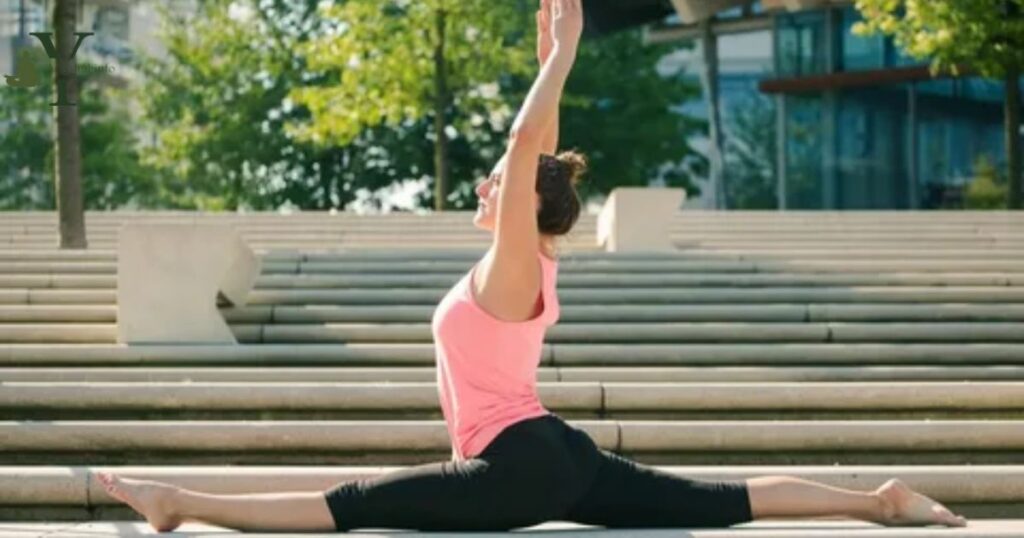
Vinyasa yoga, a dynamic and flowing practice, may seem intimidating to beginners. However, it is not reserved solely for advanced practitioners. Beginners can certainly engage in vinyasa yoga with proper guidance and modifications.
Inclusivity of Vinyasa Yoga
Vinyasa yoga classes often cater to various levels, offering modifications for beginners. Instructors guide students through breath and movement, making it accessible for those new to yoga. As beginners progress, they can gradually incorporate more challenging sequences.
Building Foundations
For beginners, starting with foundational vinyasa poses builds strength and flexibility. Consistent practice helps improve endurance and understanding of the sequences. With patience and dedication, even those new to yoga can thrive in vinyasa practice and enjoy its physical and mental benefits.
What can you expect in a typical vinyasa yoga class and sequence?
In a typical vinyasa yoga class, you can expect a dynamic and flowing sequence of poses. The class usually starts with a centering breath, bringing focus to the present moment. Sun salutations are common, linking breath with movement.
As the class progresses, expect a variety of poses like downward dog, warrior series, and balancing postures. The sequence is designed to build strength, flexibility, and mindfulness. The pace may vary, and modifications are often offered to accommodate different levels of experience.
Towards the end of the class, there is usually a cool-down phase with seated stretches and a final relaxation pose called savasana. The class aims to create a harmonious balance between physical exertion and mental relaxation, leaving you feeling rejuvenated and centered.
How can you get started?
To get started with vinyasa yoga, find a local studio or join an online class. Beginners are often welcome, and instructors provide guidance on proper alignment and breathing techniques. Invest in a comfortable yoga mat and wear breathable clothing to enhance your practice.
Start with a beginner-friendly class to familiarize yourself with basic poses and sequences. Listen to your body, and don’t hesitate to take breaks or modify poses as needed. As you progress, you can explore more advanced classes and variations. Consistency is key, so aim to practice regularly to experience the full benefits of vinyasa yoga.
Characteristics of Vinyasa Flow Yoga
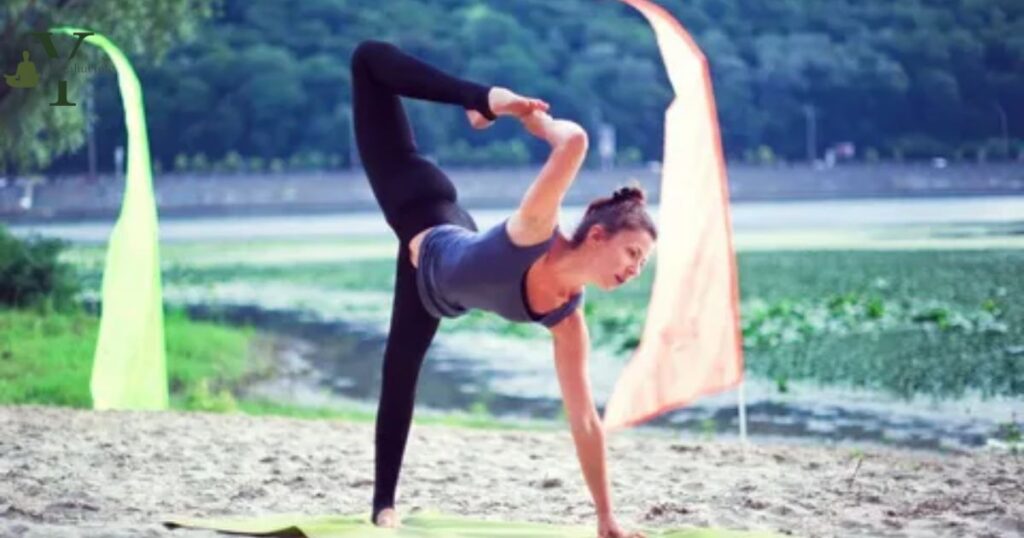
Flowing with the Breath: Unlike its static counterparts, Vinyasa Flow yoga is a dynamic dance. Each pose seamlessly melts into the next, guided by the rhythm of your breath. Inhale as you rise into Warrior II, feeling your spine lengthen and core engage. Exhale, fold gracefully into Downward-Facing Dog, grounding your heels and stretching your hamstrings. Every movement becomes a meditation, a conversation between body and breath.
Creativity Unbound: Unlike the set sequences of some yoga styles, Vinyasa embraces spontaneity. Each class is a unique tapestry woven by the teacher’s inspiration, weaving familiar postures like Chaturanga and Sun Salutations into ever-evolving sequences. It’s a playground for exploration, where you might find yourself balancing in Tree Pose one moment, twisting in Half Moon the next. No two classes are ever the same, keeping your practice fresh and challenging.
Strength and Grace: Don’t be fooled by the flowing nature of Vinyasa. This practice can be a powerhouse workout. As you move through the sequence, your muscles are constantly engaged, building strength and stamina. Holding planks and lunges will fire up your core, while graceful transitions like Chaturanga to Upward-Facing Dog challenge your upper body. But Vinyasa isn’t just about brute force. It’s also a dance of grace, cultivating coordination and flexibility as you move with fluidity and control.
Where did Vinyasa Yoga Originate?
Vinyasa Yoga originated in the ancient yogic traditions of India. The word “vinyasa” is derived from Sanskrit, meaning “to place in a special way.” The practice draws inspiration from traditional Hatha Yoga and is rooted in the teachings of the ancient text, the Yoga Korunta. However, it gained popularity in the West in the late 20th century.
The modern form of Vinyasa Yoga, as we know it today, was influenced and developed by various yoga teachers, including Krishnamacharya and his students, Pattabhi Jois and B.K.S. Iyengar. Pattabhi Jois, in particular, played a significant role in popularizing the dynamic flow of poses, creating what is known as Ashtanga Vinyasa Yoga. Over time, this style evolved and diversified, giving rise to the broader category of Vinyasa Flow Yoga that is practiced globally today.
Vinyasa Multiple Meanings
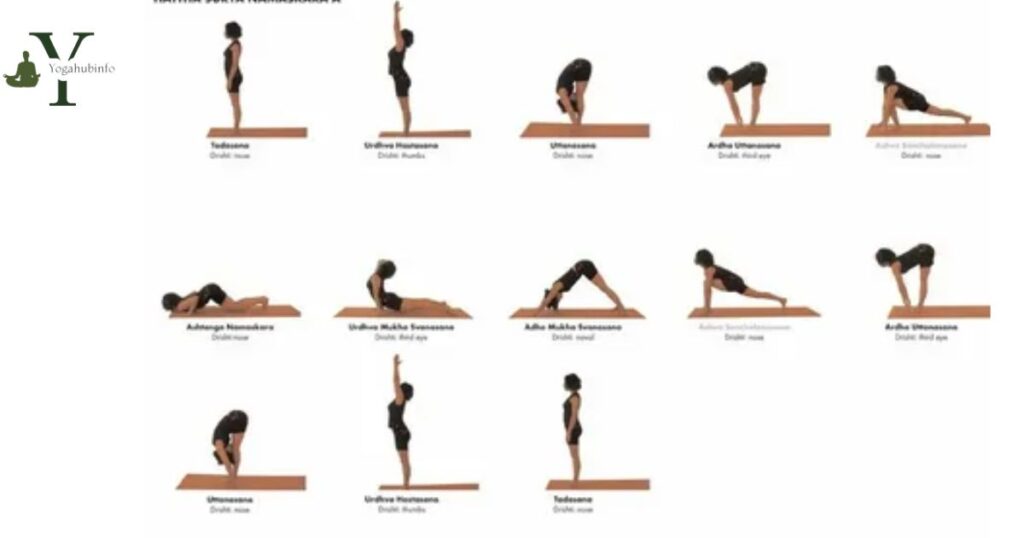
Vinyasa Flow Yoga: Where Dance Meets Strength
Vinyasa Flow yoga is a dynamic and creative style of yoga that combines breath with movement to create a flowing sequence of postures. Unlike other styles that hold poses for several breaths, Vinyasa is all about moving with intention, seamlessly transitioning from one pose to the next. This creates a cardiovascular workout that builds strength, flexibility, and endurance, while also promoting mindfulness and stress relief.
Breath is the key to Vinyasa Flow. Each inhale and exhale guides your movement, creating a rhythm that connects your body and mind. The breath also helps you generate internal heat, which can detoxify the body and leave you feeling invigorated.
Vinyasa classes are never the same. Teachers design unique sequences that may incorporate familiar postures like Sun Salutations, Chaturangas, and Warrior poses, but the order and variations are endless. This keeps your practice fresh and challenging, and allows you to explore different aspects of your own strength and flexibility.
Whether you’re a seasoned yogi or a complete beginner, Vinyasa Flow yoga has something to offer everyone. It’s a playful and accessible practice that can be modified to fit your individual needs and fitness level. So if you’re looking for a yoga style that is both challenging and rewarding, Vinyasa Flow is definitely worth a try.
Here are some additional benefits of Vinyasa Flow yoga:
- Improves balance and coordination
- Reduces stress and anxiety
- Boosts mood and energy levels
- Increases self-awareness and body confidence
Why is Vinyasa Yoga So Popular?
Vinyasa Yoga has gained immense popularity for several reasons. Firstly, its dynamic and flowing nature appeals to those seeking a more energetic and physically engaging practice. The seamless transition between poses, synchronized with breath, creates a rhythmic and meditative experience, attracting individuals looking for a holistic approach to fitness and well-being.
Vinyasa Yoga’s versatility plays a key role in its popularity. The practice is adaptable to various skill levels, making it accessible to beginners while offering challenges to more experienced practitioners. Instructors often provide modifications, allowing individuals to tailor the practice to their needs and goals.
The emphasis on breath awareness and mindfulness is another factor contributing to Vinyasa Yoga’s widespread appeal. The practice not only enhances physical strength, flexibility, and balance but also promotes mental clarity and stress reduction. In a fast-paced world, the holistic benefits of Vinyasa Yoga make it a go-to choice for those seeking a balanced and rejuvenating approach to both physical and mental wellness.
Frequently Asked Questions
What is Vinyasa Yoga?
Vinyasa Yoga is a dynamic form of yoga that synchronizes breath with movement in a continuous flow, promoting flexibility, strength, and mindfulness.
How is Vinyasa different from other yoga styles?
Unlike more static styles, Vinyasa involves a seamless transition between poses, creating a fluid and evolving practice.
Is Vinyasa suitable for beginners?
Yes, many classes offer modifications, making Vinyasa accessible for all levels, but beginners may benefit from starting with introductory sessions.
What can I expect in a typical Vinyasa class?
A Vinyasa class usually begins with a centering breath, includes various poses, and ends with a relaxation phase, fostering a balanced mind-body experience.
How does Vinyasa Yoga benefit mental well-being?
Vinyasa’s emphasis on breath awareness and mindfulness helps reduce stress, improve focus, and create a meditative state, enhancing overall mental well-being.
Final Thoughts
In essence, Vinyasa Yoga stands as a dynamic and fluid practice, seamlessly blending breath with movement. Originating from ancient yogic traditions in India, it has evolved into a versatile form that caters to practitioners of all levels. The interconnected sequences, often starting with sun salutations, create a continuous flow of postures, fostering physical strength, flexibility, and mental clarity.
The popularity of Vinyasa Yoga can be attributed to its adaptability. With variations and modifications available, it accommodates both beginners and experienced yogis, making it accessible and challenging simultaneously. The practice’s holistic approach, emphasizing mindfulness and breath awareness, resonates with individuals seeking not only physical fitness but also mental well-being in today’s hectic world.
Vinyasa Yoga transcends its ancient roots, embodying a modern synthesis of tradition and innovation. Its ability to provide a balanced, invigorating, and personalized practice underscores its significance in the contemporary wellness landscape, offering a pathway to harmony for those on the journey of self-discovery and holistic health.
Breathe, flow, transform: Vinyasa yoga, a dynamic dance where strength meets grace.

Marcus Evergreen, with 8 years of yoga expertise, is the author behind yogahubinfo.com, sharing insights and wisdom in holistic well-being.
